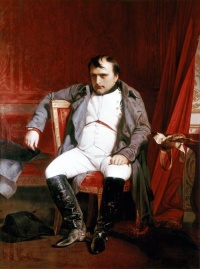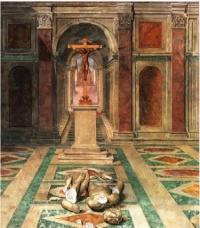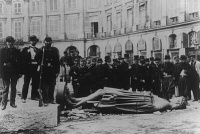Historical figure
From The Art and Popular Culture Encyclopedia
|
"There is a general consensus that Socrates—who was the main character in most of Plato's dialogues—was a genuine historical figure. It is also commonly understood that in later dialogues Plato used the character of Socrates to give voice to his own philosophical views. The Socratic problem refers to the difficulty or inability of determining what in Plato's writings is an accurate portrayal of Socrates' thought and what is the thought of Plato with Socrates as a literary device."--Sholem Stein |

|
Related e |
|
Featured: |
A historical figure is a famous person in history, such as Florence Nightingale or Napoleon.
The significance of such figures in human progress has been debated. Some think they play a crucial role, while others say they have little impact on the broad currents of thought and social change. The concept is generally used in the sense that the person really existed in the past, as opposed to being legendary. However, the legends that can grow up around historical figures may be hard to distinguish from fact. Sources are often incomplete and may be inaccurate, particularly those from early periods of history. Without a body of personal documents, the more subtle aspects of personality of a historical figure can only be deduced. With historical figures who were also religious figures attempts to separate fact from belief may be controversial.
In education, presenting information as if it were being told by a historical figure may give it greater impact. Since classical times, students have been asked to put themselves in the place of a historical figure as a way of bringing history to life. Historical figures are often represented in fiction, where fact and fancy are combined. In earlier traditions before the rise of a critical historical tradition, authors were less careful to be as accurate as possible when describing what is known of the historical figures and their actions, interpolating imaginary elements intended to serve a moral purpose to events: such is the Monk of St. Gall's anecdotal account of Charlemagne, De Carolo Magno. More recently there has been a tendency once again for authors to freely depart from the "facts" when they conflict with their creative goals.
Contents |
Significance
The significance of historical figures has long been the subject of debate by philosophers. Hegel (1770–1831) considered that "world-historical figures" played a pivotal role in human progress, but felt that they were bound to emerge when change was needed. Thomas Carlyle (1795–1881) saw the study of figures such as Muhammad, William Shakespeare and Oliver Cromwell as key to understanding history. Herbert Spencer (1820–1903), an early believer in evolution and in the universality of natural law, felt that historical individuals were of little importance.
Hegel's world-historical figure
The German philosopher Hegel defined the concept of the world-historical figure, who embodied the ruthless advance of Immanuel Kant's World Spirit, often overthrowing outdated structures and ideas. To him, Napoleon was such a figure.
Hegel proposed that a world-historical figure essentially posed a challenge, or thesis, and this would generate an antithesis, or opposing force. Eventually a synthesis would resolve the conflict.
Hegel viewed Julius Caesar as a world historical figure, who appeared at a stage when Rome had grown to the point it could no longer continue as a republican city state but had to become an empire. Caesar failed in his bid to make himself an emperor, and was assassinated, but the empire came into existence soon afterward, and Caesar's name has become synonymous with "emperor" in forms such as "kaiser" or "czar".
Søren Kierkegaard, in his early essay The Concept of Irony, generally agrees with Hegel's views, such as his characterization of Socrates as a world-historical figure who acted as a destructive force on Greek received views of morality.
In Hegel's view, Socrates broke down social harmony by questioning the meaning of concepts like "justice" and "virtue". Eventually, the Athenians condemned Socrates to death. But they could not stop the evolution of thought that Socrates had begun, which would lead to the concept of individual conscience.
Hegel said of world-historical figures,
- It was theirs to know this nascent principle; the necessary, directly sequent step in progress, which their world was to take; to make this their aim, and to expend their energy in promoting it ... They die early like Alexander; they are murdered, like Caesar; transported to St. Helena, like Napoleon ... They are great men, because they willed and accomplished something great; not a mere fancy, a mere intention, but that which met the case and fell in with the needs of the age.
However, Hegel, Thomas Carlyle and others noted that the great historical figures were just representative men, expressions of the material forces of history. Essentially they have little choice about what they do. This is in conflict with the views of George Bancroft or Ralph Waldo Emerson, who praised self-reliance and individualism, and in conflict with Karl Marx and Friedrich Engels, who also felt that individuals can determine their destiny.
Engels found that Hegel's system contained an "internal and incurable contradiction", resting as it does on both dialectical relativism and idealistic absolutism.
Spencerian view
The Scottish philosopher and evolutionist Herbert Spencer, who was highly influential in the latter half of the nineteenth century, felt that historical figures were relatively unimportant. He wrote to a friend, "I ignore utterly the personal element in history, and, indeed, show little respect for history altogether as it is ordinarily conceived." He wrote, "The births, deaths, and marriages of kings, and other like historic trivialities, are committed to memory, not because of any direct benefits that can possibly result from knowing them: but because society considers them parts of a good education."
In his essay "What Knowledge Is of Most Worth?" he wrote:
- That which constitutes History, properly so called, is in great part omitted from works on the subject. Only of late years have historians commenced giving us, in any considerable quantity, the truly valuable information. As in past ages the king was everything and the people nothing; So, in past histories, the doings of the king fill the entire picture, to which the national life forms but an obscure background. While only now, when the welfare of nations rather than of rulers is becoming the dominant idea, are historians beginning to occupy themselves with the phenomena of social progress. The thing it really concerns us to know is the natural history of society.
Inevitability or determinism
Taken to an extreme, one may consider that what Hegel calls the "world spirit" and T. S. Eliot calls "those vast impersonal forces" hold us in their grip. What happens is predetermined.
Both Hegel and Marx advocated historical inevitability in contrast to the doctrine of contingency, allowing for alternative outcomes, that was advocated by Friedrich Nietzsche, Michel Foucault and others. However, Marx argued against the use of the "historical inevitability" argument when used to explain the destruction of early communes in Russia.
As an orthodox Marxist, Vladimir Lenin believed in the ideas of history that Marx had developed, including the historical inevitability of capitalism followed by a transition to socialism. Despite this, Lenin also believed the transition could be effected faster by voluntary action.
In 1936 Karl Popper published an influential paper on The Poverty of Historicism, published as a book in 1957, that attacked the doctrine of historical inevitability.
The historian Isaiah Berlin, author of Historical Inevitability, also argued forcibly against this view, going as far as to say that some choices are entirely free and cannot be predicted scientifically. Berlin presented his views in a 1953 lecture at the London School of Economics, published soon afterwards. When speaking he referred to Ludwig Wittgenstein's views, but the published version speaks approvingly of Karl Popper, which caused a stir among academics.
Heroic view
Thomas Carlyle has espoused the "heroic view" of history, famously saying in his essay on the Norse god Odin in his book On Heroes, Hero-Worship, & the Heroic in History (1841) that "No great man lives in vain. The History of the world is but the Biography of great men ... We do not now call our great men Gods, nor admire without limit; ah no, with limit enough! But if we have no great men, or do not admire at all,— that were a still worse case." Carlyle's historical philosophy was based on the "Great Man theory", saying, "Universal History, the history of what man has accomplished in the world ... [is] at bottom the History of the Great Men who have worked here." An extreme believer in individuality, he also believed that the masses of people should let themselves be guided by the great leaders of men.
Talking of poets he said,
- That ideal outline of himself, which a man unconsciously shadows forth in his writings, and which, if rightly deciphered, will be truer than any other representation of him, it is the task of the Biographer to fill-up into an actual coherent figure, and to bring him to our experience, or at least our clear undoubted admiration, thereby to instruct and edify us in many ways. Conducted on such principles, the Biography of great men, especially of great Poets, that is, of men in the highest degree noble-minded and wise, might become one of the most dignified and valuable species of composition.
More recently, in his 1943 book The Hero in History, the pragmatist scholar Sidney Hook asserts:
- That history is made by men and women is no longer denied except by some theologians and mystical metaphysicians. And even they are compelled indirectly to acknowledge this commonplace truth, for they speak of historical personages as 'instruments' of Providence, Justice, Reason, Dialectic, the Zeitgeist, or Spirit of the Times. Men agree more readily about the consequences of the use of 'instruments' in history than they do about the ultimate ends 'instruments' allegedly serve, or the first causes by which they are allegedly determined.
Hook recognizes the relevance of the environment within which the "great man" or "hero" acted, but asserts that this can provide the backdrop but never the plot of the "dramas of human history". and distinguish life and species
Ranking
There have been rankings of the significance of major historical figures. For example, Cesar A. Hidalgo and colleagues at the MIT Media Lab has calculated the memorability of historical figures using data such as the number of language editions for which there are articles for each person, the pageviews received, and other factors. These lists are available at MIT's Pantheon project.
Historical truth
It is sometimes hard to discern whether apparently historical figures from the earliest periods did in fact exist, due to the lack of records. Even with more recent personages, stories or anecdotes about the person often accumulate that have no basis in fact. Although the external aspects of a historical figure may be well documented, their inner nature can only be a subject of speculation. It can also not be only a subject of speculation as many historical figures such as Hitler explicitly articulated their thoughts and intentions. With religious figures, often the subjects of voluminous literature, separating "fact" from "belief" can be difficult if not impossible.
Ancient figures
With older texts it can be difficult to be sure whether a person in the text is, in fact, a historical figure. "Wisdom literature" from early middle-eastern cultures (such as the Book of Job), mainly consist of verbal expositions or discussions that must be considered the work of the author, rather than the character supposedly speaking. It may still be possible to identify a figure in such texts with a historical figure known from some other context, and the text may be taken as informative about this figure, even if not verified by an independent source. On the other hand, a text may include realistic settings and references to historical people, while the central character may or may not be a historical figure.
Fables
Napoleon spoke of history as being a fable which had been agreed upon:– "la fable convenue qu'on appellera l'histoire". Great figures of the past have stories told about them which grow in the telling, and so become myths and legends which may dominate or displace the more prosaic historical facts about them. For example, some ancient chroniclers said that the Emperor Nero fiddled while Rome burned, but Tacitus disputed this by saying the stories were just malicious rumours. Similarly, there is no good evidence that Marie Antoinette ever said "let them eat cake", or that Lady Godiva rode naked through the streets of Coventry.
Personality
Thomas Carlyle pointed out that even to the person living it, every life "remains in so many points unintelligible". The historian must struggle when writing biographies, "the very facts of which, to say nothing of the purport of them, we know not, and cannot know!"
Some psychologists have sought to understand the personalities of historical figures through clues about the way in which they were raised. However, this theoretical psychoanalytic approach is not supported empirically. An alternative approach, favored by psychobiographers such as William Runyan, is to explain the personality of the historical figure in terms of their life history. This approach has the advantage of recognizing that personality may evolve over time in response to events.
Religious figures
With historical religious figures, fact and belief may be difficult to disentangle. There are cultural differences in the treatment of historical figures. Thus the Chinese can recognise that Mencius or Confucius were historical individuals, while also endowing them with sanctity. In Hinduism, on the other hand, figures such as Krishna or Rama are seen by the followers as embodiments of gods. The Nirvana Sutra states: "Do not rely on the man but on the Dharma." A teacher such as Gautama Buddha is thus treated almost exclusively as a lesser god rather than a historical figure.
E. P. Sanders, author of The Historical Figure of Jesus, called Jesus of Nazareth "one of the most important figures in human history". Various writers have struggled to present "historical" views of Jesus, as opposed to views distorted by belief. When writing about this subject, a historian who relies only on sources other than the New Testament may be criticized for implying that it is not a sufficient source of information about the subject.
The theologian Martin Kähler is known for his work Der sogenannte historische Jesus und der geschichtliche, biblische Christus (The so-called historical Jesus, and the historic, biblical Christ). He clearly distinguished between "the Jesus of history" and "the Christ of faith". Some historians openly admit bias, which may anyway be unavoidable. Paul Hollenback says he writes about the historical Jesus, "...in order to overthrow, not simply correct, the mistake called Christianity." Another historian who has written about Jesus, Frederick Gaiser, says, "historical investigation is part and parcel of biblical faith."
See also



